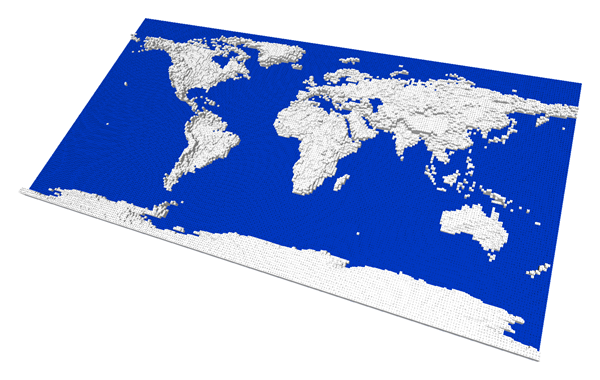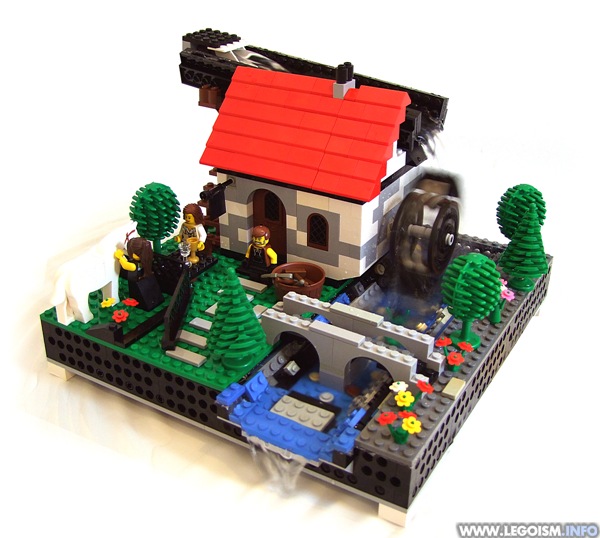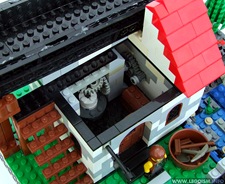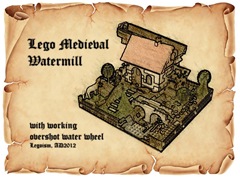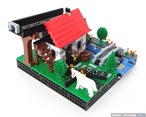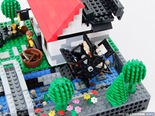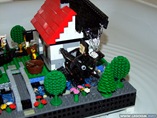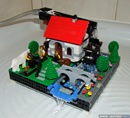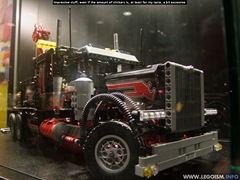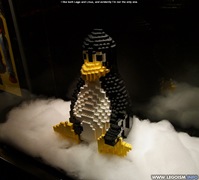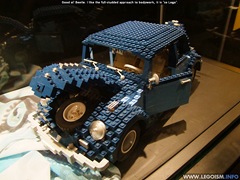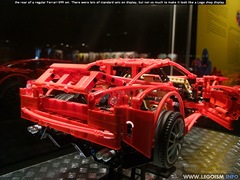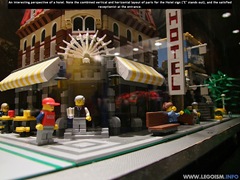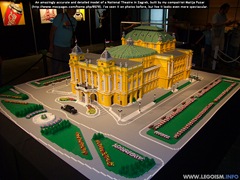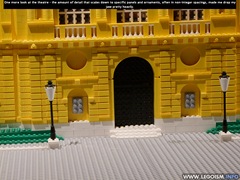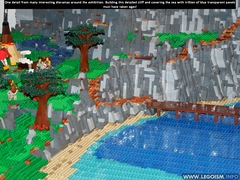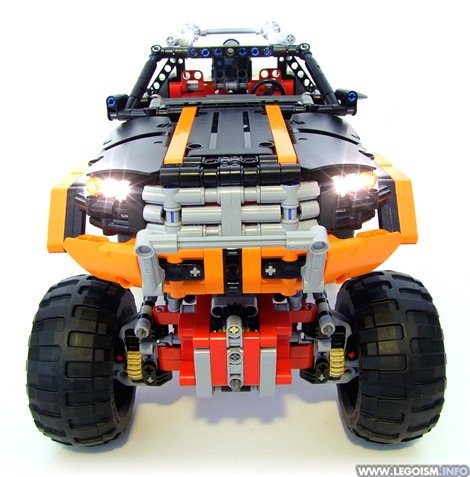
The Lego Group has always been reluctant to launch a Technic vehicle with an electric drive ― while various functions powered by electric motors aboard are quite common, the drive was entrusted to the builders' hands rather than motors. This approach is not without a legitimate reason: large powered Technic vehicles (as many MOC's attest) are usually complex to build, tend to be fragile, and often can't produce breathtaking performance. Being the construction perfectionists which they are, TLG obviously wanted to address these problems as much as possible before crossing this line. But now, with 9398 they have crossed it, introducing some important new parts along the way, thus easily qualifying the set as a "Double Milestone", as mentioned in the title.
Upon the ceremonial opening of the box, a familiar sight greets: a couple of bags numbered for easy assembly in two steps ― the chassis and the bodywork, with the latter requiring much less diligence and attention than the former.
BUILDING AND CONSTRUCTION
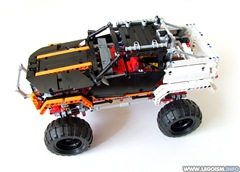 For a 4x4 crawler with dual live axle suspension, quad portal axles and all wheel steering (actually being a 4x4x4!), building isn't too difficult. Partly to thank for are the large, easily understood instructions with only a few parts added per step in average. There are three instruction booklets, with an additional diptych clarifying the correct orientation and positioning of mechanical parts in several building steps. Also, there are many auxiliary structures, such as beams and frames that hold the model together while under construction and are removed afterwards, and pins whose only purpose is to prevent you from inserting a part wrongly oriented (e.g. a differential).
For a 4x4 crawler with dual live axle suspension, quad portal axles and all wheel steering (actually being a 4x4x4!), building isn't too difficult. Partly to thank for are the large, easily understood instructions with only a few parts added per step in average. There are three instruction booklets, with an additional diptych clarifying the correct orientation and positioning of mechanical parts in several building steps. Also, there are many auxiliary structures, such as beams and frames that hold the model together while under construction and are removed afterwards, and pins whose only purpose is to prevent you from inserting a part wrongly oriented (e.g. a differential).
The front and the rear axles are largely symmetric, each holding its own power motor, while the ball links keep them connected to the main chassis where the servo PF motor is located, which controls the steering through reinforced U-joints. The chassis is actually completely independent of the bodywork and can run without it ― the bodywork is attached only at the last steps. This serves its own purpose: it is intended to be released with two pins accessible behind the openable doors, and lifted to allow easy access to the battery pack. (It could have been placed in the bodywork too, but that would probably keep the Crawler's center of mass far too high for an offroad vehicle.)
Building a 9398, one can notice some tricks, well-known among experienced MOCers, employed to ensure more strength than needed for the conventional models ― e.g. using two 1/2 bushes instead of a single fullsize bush for more friction. The overall result is staggering: this is certainly one of the structurally strongest models in Lego history, surviving rolling falls and quite severe offroading accidents without more than, say, losing a rear-view mirror. And don't think it's light: with batteries, it weighs a bit over a kilogram and a half*.
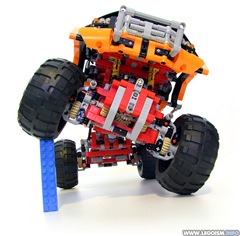 Overall, it is a satisfying model to build. Only once I've had a feeling I was fiddling with excessive detail, when assembling the front grille which consists of dozens of small parts.
Overall, it is a satisfying model to build. Only once I've had a feeling I was fiddling with excessive detail, when assembling the front grille which consists of dozens of small parts.
One may feel, and some have published, too, that the remotely controlled 4-wheel drive and steering, dual live-axle suspension and openable doors are a bit short list of functions for a Technic flagship. But I tend to disagree: toying with additional functions might make it more fragile, reduce its offroading performance, and detract from the idea of a good, focused vehicle which does one thing and does it well.
The bodywork was also designed with strength in mind, but still it looks good too, especially since it uses some less typical colours. There are no functions here ― seats and tailgate are fixed, and steering wheel, gear lever and extra lights purely decorational.
All that strength implies something else: this set is a real pain to disassemble, especially because it uses over a hundred friction axle pins, most of which are stuck into other connectors, and you will need a crater-load of patience to pluck them all out.
PARTS
Important new parts, largely responsible for the amount of attention this set has received long before it hit the shelves, are the PF L and Servo motors. As you may already know, the PF L fills the gap between a M and XL motor: noticeably more powerful than the former, but smaller and more easy to mechanically integrate than the latter. This set contains two of those and I'm sure we are going to see these motors a lot in MOC's, too.
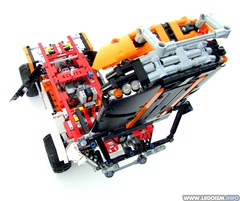 Servo, which should put an end to various recentering mechanisms, simply has its axle mimic the movements of the controller (be it small, included in this set, or the large, with 7 levels in both directions), instead of rotating at the speed proportional to it. Of course, this is a perfect part for steering in any vehicle, but will find its usage for many other applications. If you're interested in technical specifications of these new motors, take a look at Philo's website ― he has painstakingly measured them and published the results.
Servo, which should put an end to various recentering mechanisms, simply has its axle mimic the movements of the controller (be it small, included in this set, or the large, with 7 levels in both directions), instead of rotating at the speed proportional to it. Of course, this is a perfect part for steering in any vehicle, but will find its usage for many other applications. If you're interested in technical specifications of these new motors, take a look at Philo's website ― he has painstakingly measured them and published the results.
A new IR receiver has been released too, labeled "V2" at the front. It can handle more power, required to run two PF L motors adequately on a single channel, but otherwise it behaves just like the old one. In addition, we've got a new axle with a stop and a perpendicular connector, but they aren't as spectacular introductions as the PF components.
As one would expect, this is an excellent source of general Technic building material ― various beams, panels, pins, connectors, axles and similar parts are all supplied generously. Also, there is a significant amount of valuable, rare parts: beside the still über-rare new PF components, 4 large 94.8x44R tyres, 4 new triangular liftarms, 2 large ball joints, 4 portal axle housings and 2 super-hard 9.5L springs are certainly welcome to any builder's collection.
There is some amount of relatively rare white parts which may also be useful. Also there are some orange parts, but far too little for building something spectacularly orange. Majority is still, however, in the familiar red-grey-black scheme.
PERFORMANCE
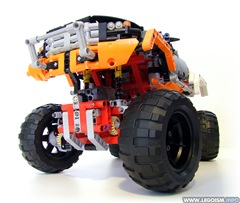 All that devotion to mechanical strength, suspension and drivetrain pays off: the Crawler is unstoppable by mere mortal obstructions. Although the instructions carefully tell not to drive it outdoors (to keep the parts from being milled by sand and stuck by dust), if you choose to live on the edge and disobey, you will find it drives over rough outdoor terrain very well ― climbs the boardwalks and hills, bridges the gaps and consistently resists tipping over.
All that devotion to mechanical strength, suspension and drivetrain pays off: the Crawler is unstoppable by mere mortal obstructions. Although the instructions carefully tell not to drive it outdoors (to keep the parts from being milled by sand and stuck by dust), if you choose to live on the edge and disobey, you will find it drives over rough outdoor terrain very well ― climbs the boardwalks and hills, bridges the gaps and consistently resists tipping over.
This performance largely owes to the portal axles and a very agile suspension (e.g. easily over 10 cm displacement for a single wheel from the plane of other three), and the PF L motors that provide serious power and torque. It is not uncommon for the Crawler, being stopped dead by a wall, to actually spin the rims inside the static, blocked tyres. The large passive torque of the motors produces one more cool effect: when they are turned off during a ride, the car just stops dead in place.
Since the axles are pointing slightly downward when the car is level, steering makes it lean into the curves, similar to the motorcycles. Extents of steering are not too wide, but thanks to the four wheel steering, the turning circle remained small enough for easy maneuvering. Without the rear wheel steering, it would resemble dragging a stubborn dog around.
You will have plenty of fun inventing all kinds of trials and obstacle tracks for the 9398, but make sure to have an assistant with wheelbarrow loaded with spare batteries follow you around. Faithfully following the image of the offroaders, its fuel consumption is not extremely economical.
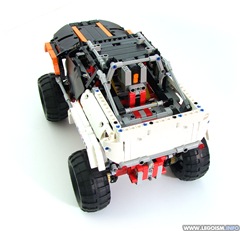 MODIFICATIONS
MODIFICATIONS
With lots of torque available onboard, it shouldn't be a problem for 9398 to carry extra weight, probably added or rebuilt at the rear, behind the cabin. Also, it should be able to pull some load or a trailer, at least not on very steep ascents.
Furthermore, since the bodywork serves no mechanical function and can be simply detached from the chassis that does all the work, it can just as easily receive any other type of custom bodywork, as long as it can attach more or less to it. In fact, a B-model truck follows this approach.
The chassis itself is less prone to modifications ― it is built very tightly and mechanical parts are reinforced like a nuclear shelter. So any attempt would probably mean rebuilding lots of components from scratch.
GENERAL PROS & CONS
+ Good, strong construction, interesting to build
+ Fun to drive (good offroad performance!)
+ Valuable new PF parts and overall building material
+ Very easy to change or rebuild a custom bodywork
- Disassembly horror
- Some components are quite fiddly to build
▪ VERDICT ▪
A Technic flagship which does well what Technic flagship need to do: provide interesting new concepts and useful parts, lots of fun building and using ― and customizing if that's your cup of tea. Cheap it certainly isn't, but the bang-for-buck ratio is still quite good. I'd be crazy not to recommend it.
*1570 g, to be precise.
GALLERY
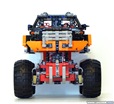
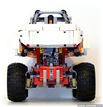
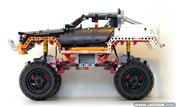


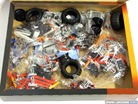

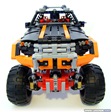


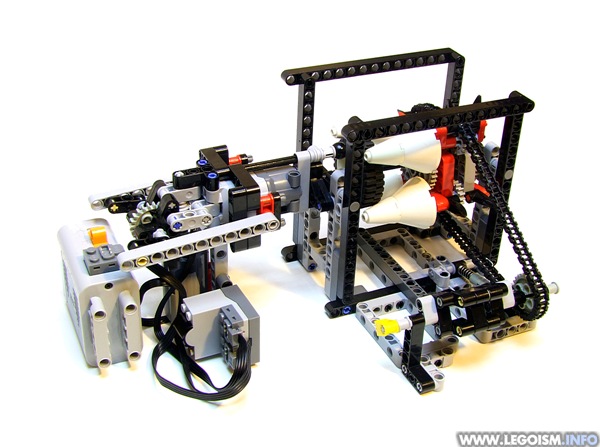 In the LEGO realm, CVT (Continuously Variable Transmission) mechanisms are by far outnumbered by standard gearboxes, but some specific systems simply require a CVT. Its most notable real-world usage is in cars ― its popularity has been steadily rising through the past decade, and will likely continue as it allows better fuel economy and, when required, better distribution of power.
In the LEGO realm, CVT (Continuously Variable Transmission) mechanisms are by far outnumbered by standard gearboxes, but some specific systems simply require a CVT. Its most notable real-world usage is in cars ― its popularity has been steadily rising through the past decade, and will likely continue as it allows better fuel economy and, when required, better distribution of power. 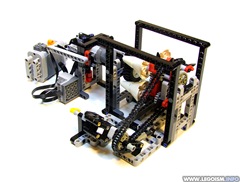 Many LEGO implementations of CVT are based on friction, often following concepts such as a variator. However, constrained by LEGO parts' mechanical limits, they are prone to slippage and thus reduce the available torque at the output. This CVT tries to work around the problem by using a chain.
Many LEGO implementations of CVT are based on friction, often following concepts such as a variator. However, constrained by LEGO parts' mechanical limits, they are prone to slippage and thus reduce the available torque at the output. This CVT tries to work around the problem by using a chain. 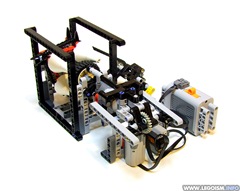 At the other end, rotation is transmitted to the secondary (receiver) sprocket ― a 24T gear. Since the primary sprocket changes its effective radius and the total chain length remains constant, the secondary sprocket needs to be movable and keep the chain under slight tension to reduce any slack. A simple arm tensioned by a soft spring, as pictured, works well for this purpose and is not much unlike the mechanism employed by many gearbox-equipped bicycles at the rear wheel. It also helps to contract the arms of the primary sprocket when the control rods and the wheels are retracting. Finally, a Schmidt coupling picks up the rotation from a moving axle of the secondary sprocket to a static axle, via three T-shaped beams. (An alternative is to use a separate third sprocket whose only task is keeping the chain tensioned.)
At the other end, rotation is transmitted to the secondary (receiver) sprocket ― a 24T gear. Since the primary sprocket changes its effective radius and the total chain length remains constant, the secondary sprocket needs to be movable and keep the chain under slight tension to reduce any slack. A simple arm tensioned by a soft spring, as pictured, works well for this purpose and is not much unlike the mechanism employed by many gearbox-equipped bicycles at the rear wheel. It also helps to contract the arms of the primary sprocket when the control rods and the wheels are retracting. Finally, a Schmidt coupling picks up the rotation from a moving axle of the secondary sprocket to a static axle, via three T-shaped beams. (An alternative is to use a separate third sprocket whose only task is keeping the chain tensioned.) 























